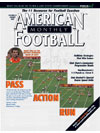AMERICAN FOOTBALL MONTHLY THE #1 RESOURCE FOR FOOTBALL COACHES
Article CategoriesAFM Magazine
|
What You Must do to be a State ChampionWe asked. You spoke. Here are the results.by: Curt Block © More from this issue For the last four years AFM has conducted a nationwide survey of championship high school coaches on a cross section of subjects that ranged from style of play to educational and coaching backgrounds. The results provided some clear cut trends while other topics illustrated subtle shifts that merit attention. The conclusions most apparent were: 1. The consistent use of ‘feeder’ programs among state championship teams. 2. A constant in the number of returning starters combining offense and defense. 3. Similar numbers of both seniors and juniors on varsity teams. 4. An average of 3-5 seniors on championship teams, per year, that go on to play college football. 5. The overwhelming popularity on defense of the four man front. 6. The consistency of overall football budgets. 1. ‘Feede....The full article can only be seen by subscribers. Subscribe today!
|
|
|||||||
| HOME |
MAGAZINE |
SUBSCRIBE | ONLINE COLUMNISTS | COACHING VIDEOS |
Copyright 2025, AmericanFootballMonthly.com
All Rights Reserved





